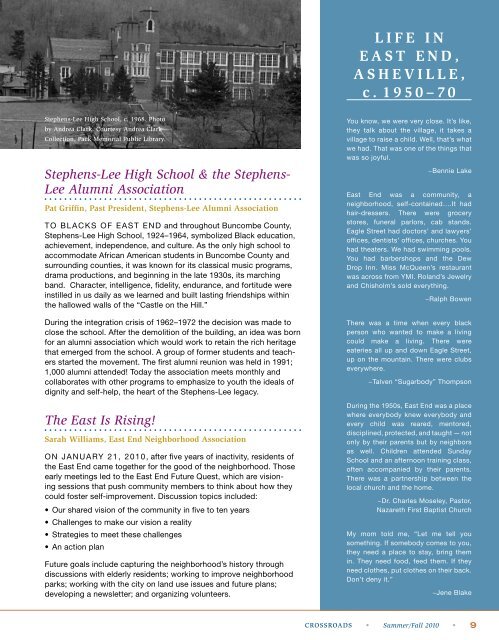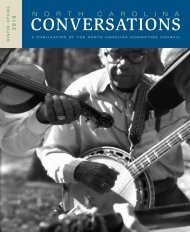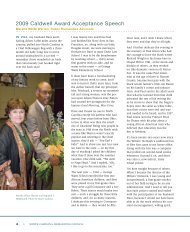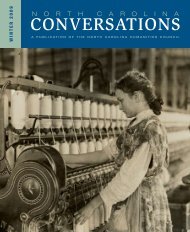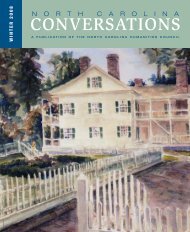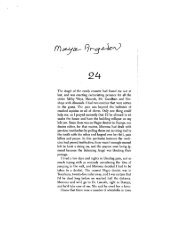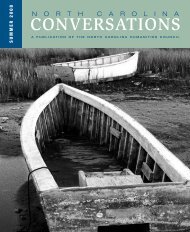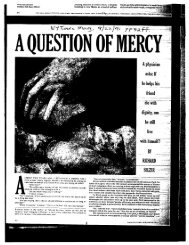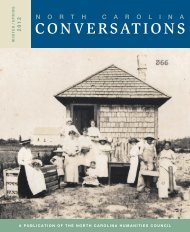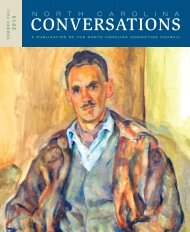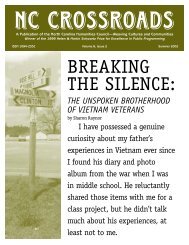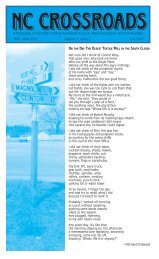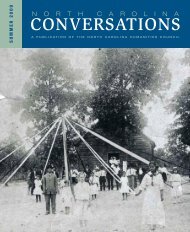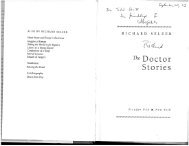Twilight of a Neighborhood - North Carolina Humanities Council
Twilight of a Neighborhood - North Carolina Humanities Council
Twilight of a Neighborhood - North Carolina Humanities Council
Create successful ePaper yourself
Turn your PDF publications into a flip-book with our unique Google optimized e-Paper software.
Stephens-Lee High School, c. 1968. Photo<br />
by Andrea Clark. Courtesy Andrea Clark<br />
Collection, Pack Memorial Public Library.<br />
Stephens-Lee High School & the Stephens-<br />
Lee Alumni Association<br />
Pat Griffin, Past President, Stephens-Lee Alumni Association<br />
TO BLACKS OF EAST EnD and throughout Buncombe County,<br />
Stephens-Lee High School, 1924–1964, symbolized Black education,<br />
achievement, independence, and culture. As the only high school to<br />
accommodate African American students in Buncombe County and<br />
surrounding counties, it was known for its classical music programs,<br />
drama productions, and beginning in the late 1930s, its marching<br />
band. Character, intelligence, fidelity, endurance, and fortitude were<br />
instilled in us daily as we learned and built lasting friendships within<br />
the hallowed walls <strong>of</strong> the “Castle on the Hill.”<br />
During the integration crisis <strong>of</strong> 1962–1972 the decision was made to<br />
close the school. After the demolition <strong>of</strong> the building, an idea was born<br />
for an alumni association which would work to retain the rich heritage<br />
that emerged from the school. A group <strong>of</strong> former students and teachers<br />
started the movement. The first alumni reunion was held in 1991;<br />
1,000 alumni attended! Today the association meets monthly and<br />
collaborates with other programs to emphasize to youth the ideals <strong>of</strong><br />
dignity and self-help, the heart <strong>of</strong> the Stephens-Lee legacy.<br />
The East Is Rising!<br />
Sarah Williams, East End <strong>Neighborhood</strong> Association<br />
On JAnUArY 21, 2010, after five years <strong>of</strong> inactivity, residents <strong>of</strong><br />
the East End came together for the good <strong>of</strong> the neighborhood. Those<br />
early meetings led to the East End Future Quest, which are visioning<br />
sessions that push community members to think about how they<br />
could foster self-improvement. Discussion topics included:<br />
• Our shared vision <strong>of</strong> the community in five to ten years<br />
• Challenges to make our vision a reality<br />
• Strategies to meet these challenges<br />
• An action plan<br />
Future goals include capturing the neighborhood’s history through<br />
discussions with elderly residents; working to improve neighborhood<br />
parks; working with the city on land use issues and future plans;<br />
developing a newsletter; and organizing volunteers.<br />
L I F E I N<br />
E A S T E N D ,<br />
A S H E v I L L E ,<br />
c . 1950–70<br />
You know, we were very close. It’s like,<br />
they talk about the village, it takes a<br />
village to raise a child. Well, that’s what<br />
we had. That was one <strong>of</strong> the things that<br />
was so joyful.<br />
~Bennie Lake<br />
East End was a community, a<br />
neighborhood, self-contained….It had<br />
hair-dressers. There were grocery<br />
stores, funeral parlors, cab stands.<br />
Eagle Street had doctors’ and lawyers’<br />
<strong>of</strong>fices, dentists’ <strong>of</strong>fices, churches. You<br />
had theaters. We had swimming pools.<br />
You had barbershops and the Dew<br />
Drop Inn. Miss McQueen’s restaurant<br />
was across from YMI. Roland’s Jewelry<br />
and Chisholm’s sold everything.<br />
~Ralph Bowen<br />
There was a time when every black<br />
person who wanted to make a living<br />
could make a living. There were<br />
eateries all up and down Eagle Street,<br />
up on the mountain. There were clubs<br />
everywhere.<br />
~Talven “Sugarbody” Thompson<br />
During the 1950s, East End was a place<br />
where everybody knew everybody and<br />
every child was reared, mentored,<br />
disciplined, protected, and taught — not<br />
only by their parents but by neighbors<br />
as well. Children attended Sunday<br />
School and an afternoon training class,<br />
<strong>of</strong>ten accompanied by their parents.<br />
There was a partnership between the<br />
local church and the home.<br />
~Dr. Charles Moseley, Pastor,<br />
Nazareth First Baptist Church<br />
My mom told me, “Let me tell you<br />
something. If somebody comes to you,<br />
they need a place to stay, bring them<br />
in. They need food, feed them. If they<br />
need clothes, put clothes on their back.<br />
Don’t deny it.”<br />
~Jene Blake<br />
CROSSROADS • Summer/Fall 2010 • 9


